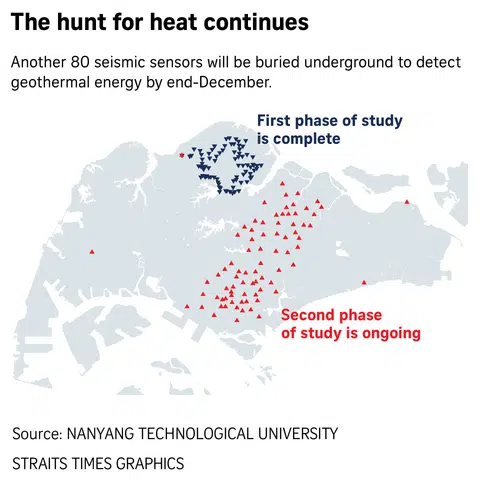NTU researchers to widen search for geothermal sources in S'pore
The search for geothermal energy in Singapore is hotting up, as researchers from Nanyang Technological University (NTU) are set to expand their search for underground heat reservoirs across the island.
Progressing to the second phase of their study, researchers will be burying another 80 seismic sensors underground, spanning the north-east and south of Singapore.
This comes after the team's breakthrough discovery of a highly fractured and shallow geothermal reservoir south-east of Sembawang Hot Spring Park in 2024.
Geothermal energy refers to heat derived from the earth's core, which is estimated to be 2,900km below the surface.
In the first phase, 80 sensors were buried about 20m beneath the ground in Sembawang and Yishun between May 2023 and September 2023, and they were recovered after 50 days for data extraction.
The vibrations recorded by the sensors were used to map out a 3D scan of structures underground.
According to Associate Professor Tong Ping, lead investigator of the study, the team will begin the next phase by the end of 2025, deploying sensors from the north-eastern Punggol Park, down to Ang Mo Kio, Tanjong Pagar and Chinatown, and towards the south, where Bukit Merah lies.
The team still needs to get permits, which are currently pending approval, from government agencies to deploy the sensors.
The study is by researchers from NTU's School of Physical and Mathematical Sciences and Earth Observatory of Singapore, and is set to uncover the sources of deep geothermal energy.
Previous studies were able to only suggest that Singapore has geothermal potential due to hot springs and above-average underground heat flow.
The sensors detect underground nano-vibrations, which reveal potential geothermal heat sources up to 4km deep, where temperatures can reach up to 200 deg C, according to a preceding study done by another NTU team.
That team found that heat between 30 deg C and 60 deg C can be used for water desalination and fish farming, while that above 90 deg C could be used for district cooling. Temperatures above 150 deg C are suited for electricity and hydrogen generation.
Dr Tobias Massier, co-leader of another NTU study, said that geothermal power plants can convert the heat into cool air, and could supply 12 per cent of Singapore's demand for air conditioning.
Vibrations caused by traffic on the ground and oceanic movement travel through layers of sediment and rocks towards the sensors. A slowdown of these vibrations suggests the presence of tiny cracks and hot fluid, said Prof Tong.
This reservoir of heat-carrying fluid has the potential to be harvested to generate electricity. But further study is required to confirm the potential.
In phase one, researchers found a drop in seismic wave speed by 12 per cent at depths beyond 1km beneath Yishun and Sembawang Hot Spring Park, indicating the presence of a geothermal reservoir.

The team's innovative approach offers a cost-effective way to map the Republic's geothermal potential by prioritising non-invasive exploration - refining where and when deep drilling is needed.
By combining advanced sensor technology with targeted drilling, the method optimises the frequency and scale of extracting granite samples, a process that can easily cost millions of dollars per campaign, depending on the drilling depth.
Prof Tong emphasised that the two strategies are synergistic: "Our technique doesn't replace drilling; it guides it. By first identifying promising zones non-invasively, we ensure drilling is used strategically, saving time and resources while maximising discovery."
Previous studies found geothermal potential in Sembawang and Pulau Tekong, with the Energy Market Authority announcing in 2021 that it was exploring the viability of employing geothermal systems in Singapore.
The study also noted that the geothermal potential of northern and eastern Singapore - the two areas identified for their higher surface temperatures and hot springs - will be studied.
To date, solar energy remains the only renewable resource that has been proven to be feasible for local use.
"What is really exciting is that Singapore, despite being far away from any volcanic regions, has world-class heat flow - nearly twice the continental average... making this promising in complementing solar and nuclear power in Singapore," Prof Tong said.
Heat flow is the movement of heat from warmer areas to cooler areas and determines how much heat is naturally available beneath the earth's surface.
These findings support Singapore's ambition to develop green energy resources to meet growing electricity demands and achieve net-zero carbon emissions by 2050, he added.
Zachary Lim for The Straits Times